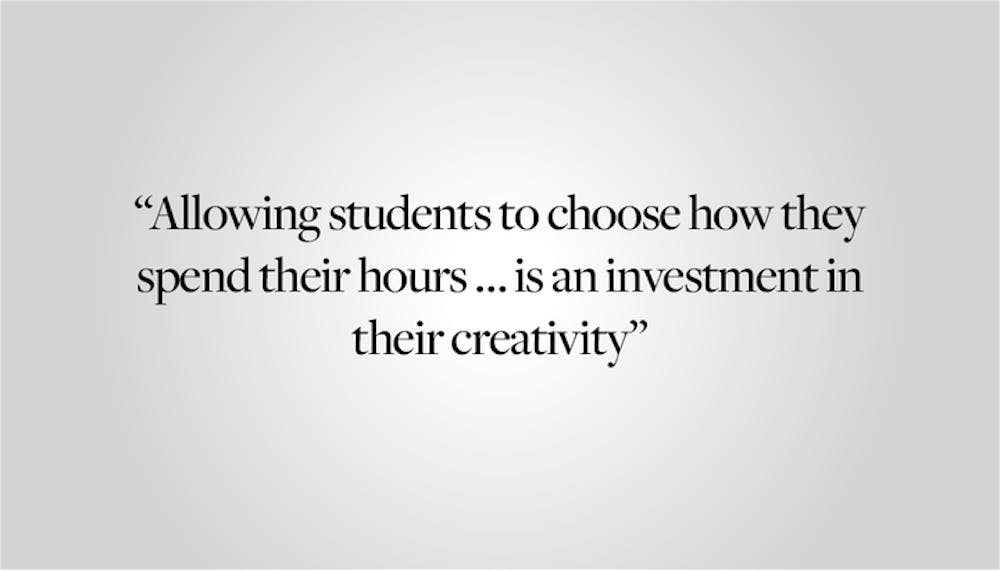As one of only a handful of no-loan universities meeting 100% of demonstrated financial need, Brown undoubtedly has one of the country’s most robust financial aid programs. The University has implemented innovative programs such as the Book/Course Material Support Program, the elimination of primary residence home equity in financial aid calculation and full-tuition scholarships for most students whose families make less than $125,000 per year. This commitment to educating bright students, regardless of their ability to pay, is laudable and indicative of the kind of university Brown strives to be. Still, there is more that Brown can and should do to remove financial barriers for students of all backgrounds.
One area where Brown can make a real impact is in eliminating its roughly $5,800 expected student contribution, a combination ofexpected summer earnings and a federal work-study. For those not familiar with the University’s financial aid calculations, of the $88,948 it costs to attend Brown for one year, the University determines what it believes your family can contribute — the expected family contribution — and makes up the difference with university scholarships. In that family contribution category, however, Brown estimates what parents can reasonably afford to pay and then tacks on nearly $6,000 more in expected student contributions. This places a burden on the 45% of students receiving financial aid to make up that gap that many of their wealthier peers do not face. To provide a truly level playing field, students, regardless of family income, should be able to focus fully on classes, extracurriculars and other pursuits without worrying about which opportunities might pay the most. Eliminating or reducing the expected student contribution, especially the summer earnings expectation, would be one positive step in that direction.
While over the course of a summer, $3,000 might not seem like too much to ask of students, one possible consequence of this policy is that students might have to turn down a more meaningful internship opportunity for one that pays enough to cover rent, but not enough to also cover their expected contribution. Summer/Semester Programs for Research, Internships and Teaching funding opportunities, such as the LINK award which supports students pursuing unpaid internships or low-paid positions, might partially fill this gap. But the $2,000 pay cutoff for eligibility creates a benefits cliff that renders a number of opportunities inaccessible. Furthermore, the summer earnings waiver which suspends the expectation of student tuition contributions from summer earnings can only be exercised once in conjunction with a SPRINT award. In today’s competitive job market, internships are a key currency for social mobility, and making it harder for low- to middle-income students to explore these opportunities prevents some from fully reaping the benefits of a Brown education. While Brown lowered its summer earnings expectation by $1,000 for students with the most need in 2021, those students are still expected to cover at least $1,700 of their own tuition costs over the summer as well as $2,950 for unbilled expenses through work-study — and many other students on aid are expected to cover more than that. Recognizing this problem on their own campuses, many of Brown’s Ivy peers such as Dartmouth, Harvard and Yale have all reduced their earnings expectations to only account for unbilled costs during the year.
More significantly, Brown should follow the example of schools such as Princeton and Williams College which have completely replaced the student contribution component of their aid packages with grant funding. In a press release explaining its rationale, Princeton stated the move would “provide more opportunities for students to study abroad and to pursue other curricular and co-curricular activities during the summer and academic year.” Allowing students to choose how they spend their hours, instead of limiting their options to cover costs is an investment in their creativity. Furthermore, study abroad and athletic opportunities, both of which effectively preclude work-study, should not be less accessible to students receiving aid. Further reducing or eliminating the expected student contribution is a small price to pay for a wealthy university such as Brown, which prides itself on its promotion of academic curiosity and freedom. The University can afford to make this investment and doing so would go a long way toward fostering equity on campus.
Beyond just financial aid calculations, there are a number of measures Brown can adopt to promote greater economic diversity in its student body such as by accelerating the implementation of plans to become need-blind for international students. Recognizing Brown’s place as a global leader in education, we must ensure that our gates remain open to all deserving students across the globe. Further, Brown can follow the lead of institutions such as Harvard and Yale which support their highest-need students by providing “start-up grants” for educational materials — or, in the case of Bowdoin College, directly providing their students with laptops and iPads.
The strength of Brown lies in the strength of the students it attracts. Giving all students the chance to focus fully on their passions embodies the ethos of the Open Curriculum and would enable students to reach their full potential without worrying about financial considerations. There is so much work that has been done — and so much work left to be done in ensuring that a Brown education is truly open to all. Brown cannot be complacent in what it has already accomplished — it must begin this hard work today.

Tas Rahman is an opinions editor at the Brown Daily Herald writing about issues in higher education. When he's not coding or studying biochemistry, you can find him hiking and enjoying the great outdoors.





